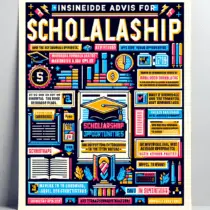Educational costs can often be daunting, but scholarships offer a silver lining to fund various academic pursuits. Navigating through thousands of potential scholarships can seem overwhelming. However, with targeted strategies, one can effectively maximize their chances of securing funds for their education. This article aims to provide insider advice on making the most out of scholarship opportunities while touching upon specific scholarships such as the “Advanced Robotics ¥750,000 Scholarship in Japan, 2024” and the “$3000 Global Health Leaders Scholarship Japan, 2024.”
Start Early
Initiating your scholarship search early offers multiple advantages. It provides ample time to explore various opportunities, understand their requirements, and prepare robust applications. High school juniors, for example, can begin compiling a list of potential scholarships they wish to apply for during their senior year. This proactive approach allows sufficient time to gather necessary documents, write essays, and solicit recommendation letters.
Scholarship Types and Breadth of Search
To optimize scholarship chances, one must cast a wide net. Scholarships come in multiple forms: need-based, merit-based, field-specific, and demographics-specific. For instance, tech enthusiasts might be interested in the “Advanced Robotics ¥750,000 Scholarship in Japan, 2024,” a generous offer for students keen on advancing in the field of robotics.
Moreover, students committed to healthcare can apply for the “$3000 Global Health Leaders Scholarship Japan, 2024.” This scholarship supports those aspiring to make a mark in the global health domain.
Organize Efforts
Organization is paramount when applying for multiple scholarships. Creating a spreadsheet with columns such as scholarship name, deadline, requirements, and status can help applicants keep track of their progress. Regularly updating this document ensures no application is missed, and deadlines are met punctually.
Tailored Applications
Scholarship committees seek candidates who resonate with their mission. A tailored application can significantly augment one’s chances of success. For example, when applying for the “Advanced Robotics ¥750,000 Scholarship in Japan, 2024,” applicants should highlight their passion for robotics, relevant coursework, projects, and future aspirations in the domain. Distinctly aligning one’s application to the scholarship’s goals can set it apart from generic submissions.
Craft Stellar Essays
Essays often form a critical component of scholarship applications. A compelling, well-crafted essay can distinguish an applicant amidst a sea of contenders. It’s essential to adhere to the essay prompt and articulate one’s thoughts clearly and concisely. Personal anecdotes, future goals, and experiences relevant to the scholarship can make the essay more engaging.
Strong Recommendation Letters
A glowing recommendation letter from a credible source can immensely bolster an application. Choosing the right recommenders—those who know the applicant’s strengths, achievements, and potential—can make a difference. It’s crucial to provide recommenders sufficient time and information (resume, achievements, future goals) to write detailed and personalized letters.
Highlight Extracurricular Involvement
Scholars are not solely evaluated on their academic prowess. Extracurricular activities, leadership roles, community service, and unique talents can significantly enhance an application. Scholarships like the “$3000 Global Health Leaders Scholarship Japan, 2024” may value leadership and initiative in the health sector, making related extracurricular activities a crucial element of the application.
Customize Financial Statements and Aid Application
Need-based scholarships often require detailed financial statements. Transparency and accuracy in representing one’s financial need are essential. Additionally, filling out the Free Application for Federal Student Aid (FAFSA) or the respective country’s counterpart can open doors to various need-based scholarships and grants.
Utilize University Resources
Most universities have dedicated scholarship offices or advisors. These professionals can offer invaluable guidance, review applications, and provide insights into lesser-known scholarships. Universities also maintain databases of institutional scholarships, which often have fewer applicants and thus higher chances of success.
Practice Interview Skills
Some prestigious scholarships may involve an interview stage. Practicing common interview questions, presenting oneself confidently, and articulating one’s aspirations and qualifications fluently can leave a lasting impression on the interviewers.
Leverage Online Tools and Platforms
Numerous online platforms offer comprehensive databases of scholarships. Websites like Fastweb, Scholarship.com, and the College Board provide customized scholarship matches based on user profiles. Regularly checking these platforms and updating profiles ensures relevant scholarship opportunities are identified timely.
Pay Attention to Small Details
Small details can make a significant impact. Ensuring the application is free from grammatical errors, all documents are correctly labeled, and the format adheres to specified guidelines can reflect an applicant’s diligence and commitment.
Explore International Scholarships
Global education avenues are increasingly becoming accessible through international scholarships. These opportunities not only provide financial aid but also enhance global exposure. For instance, the “Advanced Robotics ¥750,000 Scholarship in Japan, 2024” offers students a credible platform to engage with cutting-edge robotic technologies in Japan. Similarly, the “$3000 Global Health Leaders Scholarship Japan, 2024” enables students to interact with global health leaders and gain invaluable insights.
Seek Feedback
Before submitting applications, seeking feedback from mentors, peers, or professional advisors can provide constructive insights. They can identify areas of improvement, suggest enhancements, and validate the application’s efficacy.
Persistence Pays
Persistence and resilience are crucial. Rejection from one scholarship should not deter applicants from pursuing others. Each application is a learning curve, refining the skills and elements required to secure future scholarships.
Collect and Maintain a Portfolio
Creating a portfolio of academic and extracurricular achievements and regularly updating it can be handy when applying for scholarships. This compilation serves as a quick reference to pull information, achievements, and proof of credentials, making the application process smoother.
Engage in Relevant Networking
Networking can open doors to exclusive scholarship opportunities. Engaging with academic circles, participating in relevant seminars, and joining professional organizations related to one’s field of study can provide insights and access to scholarships that are not widely advertised.
Conclusion
Maximizing scholarship opportunities involves a blend of strategic planning, organizational skills, strong applications, and resilience. By exploring a broad range of scholarships, such as the “Advanced Robotics ¥750,000 Scholarship in Japan, 2024” and the “$3000 Global Health Leaders Scholarship Japan, 2024,” tailoring applications to resonate with specific criteria, and leveraging available resources, students can significantly enhance their chances of securing financial support for their educational pursuits. The journey might be meticulous, but the rewards of securing scholarships make the endeavor worthwhile, paving the way for academic and professional fulfillment without the undue worry of financial constraints.






